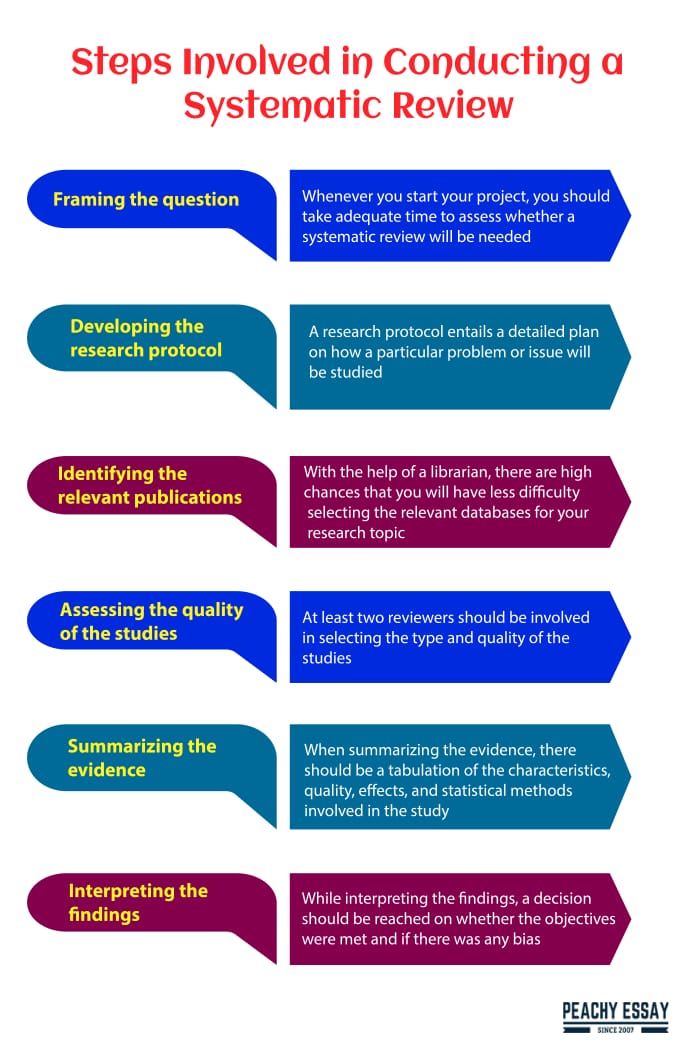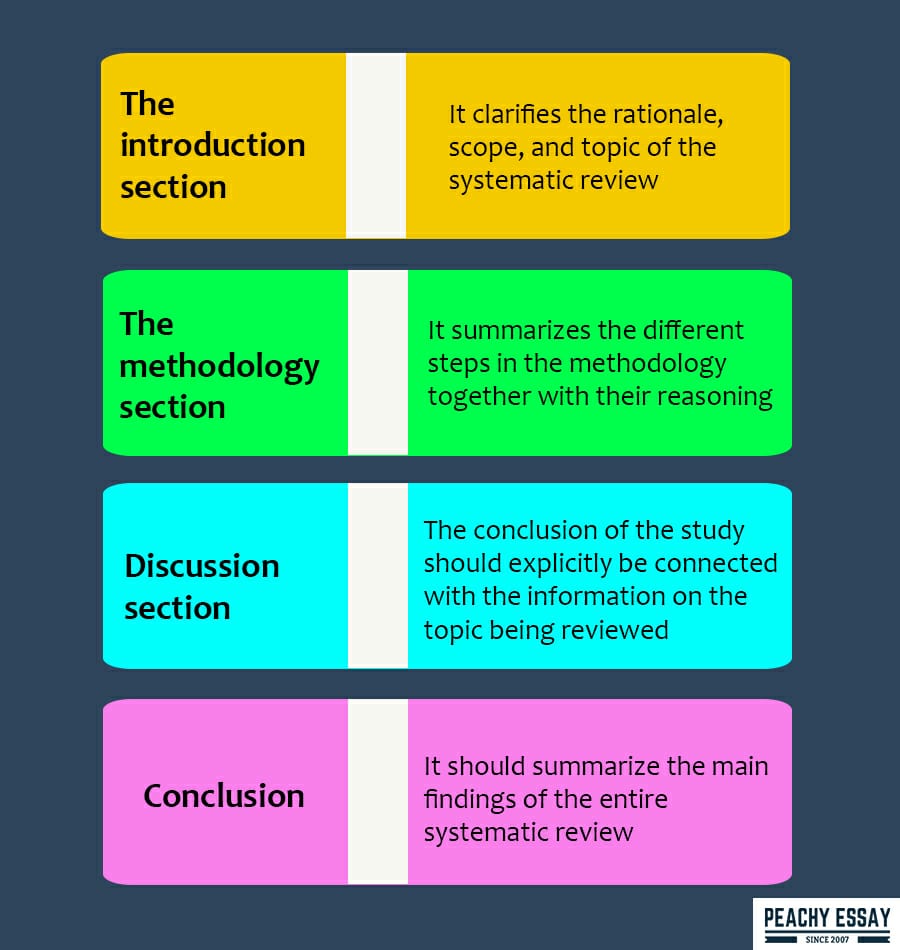In the ancient days, the task of reading and thereafter making sense out of literature was not so complicated. The entire process was easy for the apparent reason that the literature was not that advanced. However, many years later, there have been significant changes in the research landscape. Currently, reading and making sense of the literature have become more stressful, time-consuming, and complicated. There are tons of literature, which is now expanding exponentially, and people can share skills and knowledge in various parts of the world using the Internet. There is a constant emergence of literature, constructs, and new theories integrated to identify and thereafter understand different constructs, processes, and mechanisms. Literature reviews, and more so the systematic reviews, aim at bringing out together, synthesizing, and critiquing one or more pieces of literature. They aim to provide a general impression of quality, nature, and the extent of evidence regarding specific research or question existing in the gap between what is known and what should be known. When conducted appropriately, systematic reviews provide a means of making sense from large quantities of scientific pieces of literature.
What is a Systematic Review?
A systematic review entails a distinct type of literature review that offers many added advantages. It involves assessing a formulated question that uses explicit and systematic methods in identifying, selecting, and critically appraising different relevant pieces of research. Notably, a systematic review is mainly characterized by being replicable, transparent, comprehensive, and organized. A systematic review involves various research processes that are aimed at locating all relevant published and unpublished work that addresses different research questions. It is important to note that the primary objective of a systematic presentation and methodology is minimizing bias and subjectivity. The most effective systematic reviews implicitly use a literature review to develop a new theory and evaluate an existing approach.
There is an explicit approach in a systematic review that permits the readers to review and assess the author’s procedures, assumptions, and conclusions, instead of taking them on faith. On the same note, it is essential to note that the methodology used in systematic reviews allows other researchers to update and extend various reviews to a later time. The researchers are advised to adopt the mindset of a judge and jury if they want to attain the objectives of a systematic review. This is because the judge and jury skeptically evaluate the evidence to make the fairest judgment.
What is the Purpose of a Systematic Review?
When discussing the primary objective of a systematic review, it is essential first to imagine a scenario where you might have wanted to know more about the impact of global warming on the environment. To acquire a better understanding of the topic, the ideal thing you would do is conducting a review of the literature. This is because a literature review combines information from different research papers and aids an individual in responding to specific questions. However, using a literature review to understand a particular topic better is usually limited. This is because an individual researches topics that have been conducted or those that support their argument or hypothesis. On the same note, the researcher ignores the literature that is contrary to their hypothesis. An individual may consider performing a systematic review for the simple reason that it is designed for overcoming various forms of bias, and they are more rigorous in a particular area. Most straightforwardly, a literature review entails critically appraising, summarizing, and reconciling evidence.
In essence, the main aim of a systematic review should be to answer essential answerable clinical questions and identify various areas that are important yet underreported. The questions must be specific since, if it is broad, the reviewer will have difficulties focusing on the central literature. However, on the contrary, if the topic is too narrow, the researcher will experience problems trying to access enough published information that will respond to the identified questions. However, it is essential to note that the questions of a systematic review should always be focused and original.
Systematic Review Methodology
Notably, systematic reviews require more human resources and time when compared with the traditional literature reviews. When writing your systematic review methodology, it is essential to consider the following:
- Whether there is adequate literature published on the topic that will need a review
Systematic reviews are often aimed at distilling the evidence from different studies and convert them into actionable insights. Is there a need for more primary research to be conducted or there is adequate literature on the topic?
- Can the research question be answered using the systematic review?
It is essential to note that systematic review questions must be clearly defined and specific. On the same note, researchers should never forget that the research question will significantly determine the research strategy, inclusion criteria, and data to be extracted from specific studies. Therefore, it is important to ensure that your research questions are clearly defined right from the beginning of the review.
- Is there a protocol that will aid in drawing the review plan?
As a researcher, you should have a protocol since it is one of the roadmaps for the review project. Notably, a good protocol should precisely outline the study’s methodology, including all the objectives for the systematic review. On the same note, it should describe the main questions, which are further divided into the PICO elements. Having a protocol also provides a good place for planning out exclusion or inclusion criteria, management methods, data abstraction, and the process through which different studies will be assessed.
- Is there any team of experts present?
Conducting a systematic review requires a lot of team effort. Therefore, having more reviewers will assist you in strengthening the analysis and minimizing bias. The team should comprise the subject expert, a librarian who will conduct the research, two literature screeners, and a statistician that will assist you in analyzing the gathered information.
- Is there adequate time to conduct a systematic review?
It is important to note that carrying out a systematic review requires a lot of time and effort. Typically, it will take 12-18 months to conduct an effective systematic review.
- Is there a method to discern bias
There are different forms of bias, and they may include selection, performance, and reporting bias. Therefore, it is essential to assess some of the risks associated with bias in individual research, especially in your research design.
- Can the article be in languages other than English?
When writing your systematic review, it would be best to include all the relevant studies, irrespective of the language in which they were published. This will aid in avoiding language bias.
Systematic Review Steps
There are five steps involved in conducting a systematic review. They include: framing the question, identifying the relevant publications, assessing the quality of the studies, and interpreting the findings.

- Framing the question
Whenever you start your project, you should take adequate time to assess whether a systematic review will be needed. Are there researchers who have already researched your topic? If you have difficulty determining whether research has been done on your topic, you might consider seeking help from the librarian. On the same note, it is important to consider whether there is adequate time to perform a systematic review. Some researchers take more than a year to complete a systematic review.
- Developing the research protocol
A research protocol entails a detailed plan on how a particular problem or issue will be studied. A well-written research protocol should contain details such as the research objectives, the specifics of the processes and methods to be utilized, and the eligibility of the criteria used for different studies. There should also be a detailed description of how the information will be obtained from individual studies and, finally, the type of analyses that should be performed.
Your research protocol should include the following essential elements: the exclusion and inclusion criteria, searching strategies, study processes, selection, the data extraction process, the assessment of the quality processes, data synthesis method, and results in dissemination plans. Whenever you are developing a research protocol, you should include the review’s objective and the question elements.
- Identifying the relevant publications
Researchers are always advised to partner with the librarian when conducting their systematic reviews. The primary objective is to locate all the relevant studies that have been conducted on your topic. Therefore, your review should be thorough and detailed. With the help of a librarian, there are high chances that you will have less difficulty selecting the relevant databases for your research topic. When doing your research, you may consider taking note of the following essential details: the number of results obtained, the different strategies used, the dates the pieces of information were obtained, and the various searched databases.
- Assessing the quality of the studies
At least two reviewers should be involved in selecting the type and quality of the studies. It would be best if you never forgot to use the criteria described or documented in your protocol. When you perform screening for the first time, it should be based on the abstracts and the titles. The second round of screening should be completed using full-text articles. Finally, it would be best if the reviewers kept a list of the excluded studies and the reasons for their omission.
- Summarizing the evidence
When summarizing the evidence, there should be a tabulation of the characteristics, quality, effects, and statistical methods involved in the study. The exploration of heterogeneity together with its sources should be planned in advance.
- Interpreting the findings
While interpreting the findings, a decision should be reached on whether the objectives were met and if there was any bias. The results will aid in determining whether the overall conclusions of the systematic review can be trusted.
Qualitative vs. Quantitative Research
A systematic review can be divided into qualitative and quantitative systematic reviews. One of the most significant differences between the two is that quantitative research deals with statistics and numbers when collecting and analyzing data, while qualitative research, on the other hand, deals with words and meanings. However, it is essential to note that both play a vital role in gaining different forms of knowledge.
Differences Between a Systematic Review and a Literature Review
There are significant differences between a literature and a systematic review. First, a systematic review entails a high-level overview of the primary research of a particular question, whereas a literature review summarizes the evidence on a specific topic using subjective or informal methods to collect and thereafter interpret data. The primary objective of a systematic review is eliminating bias, while a literature review aims to provide an overview or a summary of a topic.
What is the difference between a review and a systematic review?
A review is performed chiefly without following any specific criteria. However, a systematic review is performed based on different chosen criteria, emphasizing adequacy and accuracy. It is essential always to remember that specialists may govern the different criteria used for systematic reviews.
What are the limitations of a systematic review?
Most limitations arising from systematic reviews are mostly linked with the interpretation and a critical appraisal of the systematic review. One way of interpreting and making the information gathered in a systematic review transparent is by developing different guidelines for reporting the studies captured in the review.
Secondly, a systematic review is not as detailed as a literature review. They often fail to provide information on the research strategy used in different articles, the limitations of different sources, and the quality of the research processes. Most importantly, they do not capture information on how research analysis was conducted.
What kind of research is a systematic review?
A systematic review is a type of research that entails a reproducible and critical summary of the available publication results regarding a particular clinical question and topic. If the researcher wants to improve the scientific writing and implement a systematic review, the methodology section should be structured appropriately.
What is the first stage of a systematic review?
Despite the advancement of the guidelines for efficiently conducting a systematic review, the basic steps often start from framing questions, then identifying relevant work, which consists of criteria development and searches for articles, evaluate the quality of included studies, encapsulate the evidence, and interpret the results.
The first stage of a systematic review is creating the research questions and the objectives. Like other research designs, the research questions for a systematic review must be relevant, ethical, engaging, and feasible. Two of the standard tools used in formulating research questions are SPIDER and PICO. Notably, PICO (Population, Intervention, Comparison, Outcome) is used to synthesize qualitative evidence. Researchers believe that it holds a higher degree of sensitivity than the SPIDER (Sample, Phenomenon of Interest, Design, Evaluation, Research type) approach. It is recommended that researchers should utilize a combined approach of both SPIDER and PICO when retrieving comprehensive research. However, it is believed that a SPIDER approach, in most cases, is more effective.
Essential Sections of a Systematic Review

The introduction section
It clarifies the rationale, scope, and topic of the systematic review. The review should start with a catchy paragraph that introduces the problem or topic and the main questions that will be addressed in the systematic review. Generally, systematic reviews are followed by a few sections that summarize how the study will be structured as well as what it will cover, possibly stating some objectives for the review.
The methodology section
It summarizes the different steps in the methodology together with their reasoning. On the same note, the method section should clearly describe what and why the research did a particular thing while conducting the systematic review. There should also be a comprehensive description and systematic literature that includes the research terms used, the inclusion and exclusion criteria, and the specific databases utilized. There should also be a description of the efforts made to locate and thereafter include all the published and unpublished literature on the topic.
Discussion section
The researcher will need to summarize and discuss the different findings of the systematic review in an impartial and balanced way based on the context of the previous theory. The conclusion of the study should explicitly be connected with the information on the topic being reviewed. The discussion section should also discuss the strengths, limitations, and methodological problems involved in the literature.
Conclusion
It should summarize the main findings of the entire systematic review. An individual should be cautious not to make it too long. Also, new ideas or concepts should not be mentioned in the conclusion.




